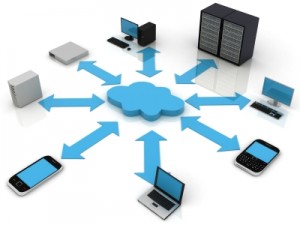Cloud Computing An Insight – Know Your Clouds
 Cloud Computing has been the most hyped terms in recent times, a prolific technology that is flourishing like anything . With so much tangible benefits it garners, every organization has started thinking about Clouds. In this article, we provide some basic ideas about Cloud Computing and some of its issues.
Cloud Computing has been the most hyped terms in recent times, a prolific technology that is flourishing like anything . With so much tangible benefits it garners, every organization has started thinking about Clouds. In this article, we provide some basic ideas about Cloud Computing and some of its issues.
Cloud Computing allows consumers and businesses to use applications without installing at their ends and access their personal files just with internet access. This technology allows for much more efficient computing and processing, about which the end users have to be least bothered. For ex-Yahoo-mail and Gmail happen to provide such features, where we are not concerned with server and software and run application at our end to access our information.
Private, Public and Hybrid Clouds :
- Private Clouds are deployed at the user’s end with the maintenance and management part left for the user. So, if private clouds let anyone feel secured about the data, adds substantial burdens too.
- Public Cloud services relieve one of the management burden but at the expense of some control. The direct benefits are in easy and inexpensive set-up because hardware, application and bandwidth costs are covered by the provider. Amazon Elastic Compute Cloud (EC2), Google AppEngine and Windows Azure are some examples under this category.
- Hybrid Clouds are often useful for archiving and backup functions, allowing local data to be replicated to a public cloud. It allows to take advantage of scalability and cost-effectiveness of a public cloud without exposing critical applications and data to third-party vulnerabilities.
Private clouds are little less likely to be used because no one wants to accept the burdens. Although public cloud computing has valid applications, the path to public cloud computing is not all that clear. Hybrid clouds combine the best of both worlds – offering the security, privacy, and control of the private clouds for sensitive information, as well as the greater elasticity of the public clouds. They are the demand of present.
Component of Cloud Computing :
- SAAS (Software As A Service)- It’s the applications layer delivering focused on software capabilities to the organizations of various types. Vendors host a single, centralized version of the applications software and each customer accesses its own instance. The security is of course a main concern in this layer. It’s vendors include Salesforce.com, NetSuite etc.
- PAAS (Platform As A Service)- This layer provides services to develop, test, deploy and maintain applications in the same integrated development environment. It helps the developers to get an insight into the inner workings of their applications, and the behavior of their users. Major PAAS vendors are Microsoft Azure, Salesforce.com’s Force.com etc.
- IAAS (Infrastructure as a Service)- It offers compute power, storage, and networking infrastructure as a service via the public internet. Vendors use virtualization technologies to provide compute power. Amazon, GoGrid, Rackspace are major IAAS vendors.
Over the past few month there has been a shift of interest of the IAAS public clouds to morph into more like PAAS operators. End-users in the enterprise only care about the application, not the infrastructure supporting it. So, PAAS gets a big benefit with its zero administration requirements over IAAS and moreover, many basic IAAS features come along with PAAS too. SAAS is the fastest growing cloud category. Low cost, low risk, scalability, longevity etc. are the key features which lead the SAAS to its paramount position.
Major Concerns in Cloud Computing -
Cloud Security :
To protect and secure sensitive information in cloud computing has always been a challenging issue. The basic problem is that cloud services come from virtual networks. Using the typical network security solution, therefore seems implausible. Since all the data is handed over to the service provider, there arises a problem of security. The security threats occur mainly when hacker or other such people try to get free services or target customer infrastructure. Choosing a good service provider can help.
Recently, we saw breach in case of Sony’s data where as many as 100 million users’ information had to be compromised. Cloud-based password storage and management company LastPass announced a possible successful hacker’s attack against its servers. And there are many other cases too.
Outages :
About a fortnight ago, Amazon Web Services (AWS-Amazon’s cloud-based service) knocked off many web sites, making them inaccessible for many hours. Many other outages have occurred, raising eyes on the performance of cloud computing. These outages are mainly outcomes of some changes that the service providers try to incorporate, but they fail.
Such fiascos are inevitable, but some practices at the user end can lessen the impacts. For ex- maintaining back-ups can really help in such failures, designing a site’s architecture so that it is resilient to occasional failures and outages- can surely help.
Data Integration:
Integration is the top concern for enterprises adopting a SAAS or cloud-based solution. It needs an understanding of requirements, data volumes (both present and long termed), integration complexities and resources otherwise everything turns futile.Also one business may be catered by various clouds, so cloud-cloud integration and interoperability are also important issue.
Cloud Computing surely is in its infancy, yet so much promising and has a lot to offer. The key player of Cloud are doing each and everything for development of this technology. We need to be tenacious and extract the best of it. The benefits that it provides are significant. Very soon ‘Cloud’ is going to be an omnipresent entity in the IT sphere and overshadow everything else.